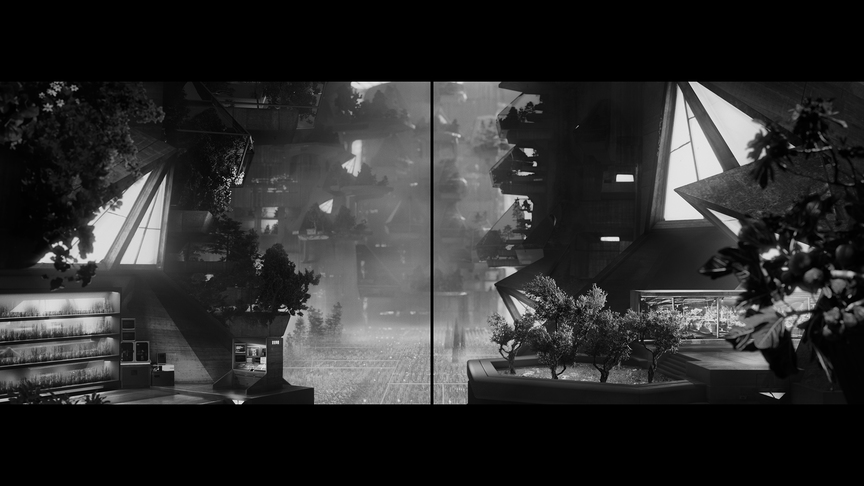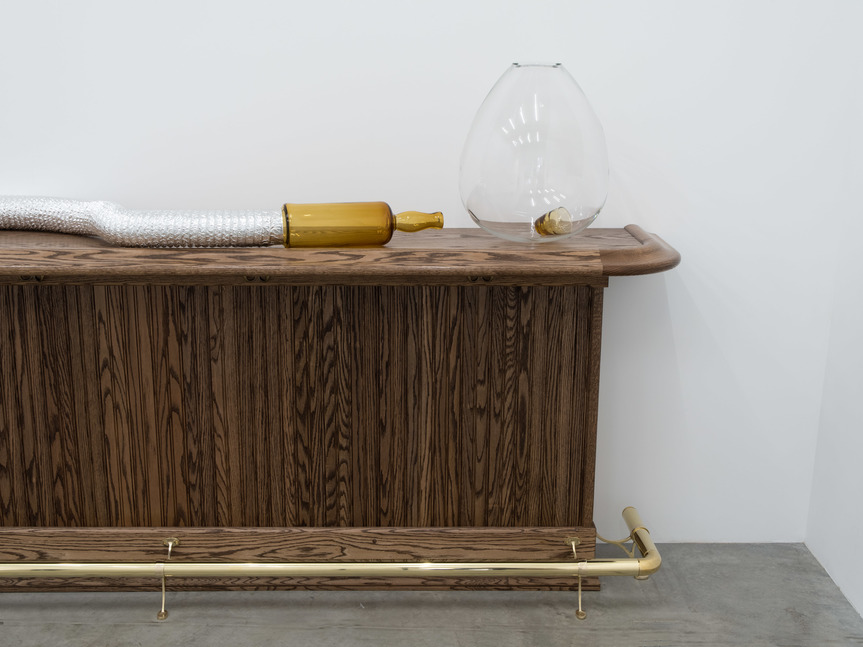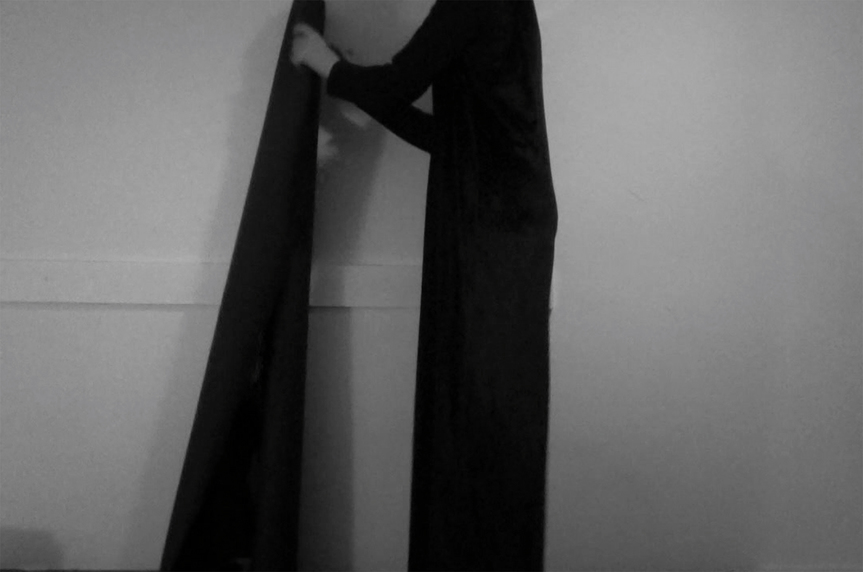-
From Issue 114
- Web Exclusives
- Archive
- Subscribe

R
E
V N
E
X
T
LARISSA SANSOUR
A horrifying deluge of oil-black liquid courses through narrow stone streets; it pours into the sacred interior of Bethlehem’s Church of the Nativity. A mother runs into her stone house, grabs her daughter, and they flee their neighborhood as billows of smoke fill the skyline behind them. These scenes appear as flashbacks throughout Larissa Sansour’s two-channel, black-and-white film In Vitro (2019), co-directed with Søren Lind, and presented in the Denmark Pavilion, “Heirloom,” at the 58th Venice Biennale. The woman who is experiencing these memories is named Alia (Maisa Abd Elhadi) and she is a clone of the daughter seen in the flashbacks. She lives in an underground orchard city where the survivors took refuge; when she visits a gigantic black orb she experiences memories from before the catastrophe of a place she herself has never been to. The mother, Dunia (Hiam Abbass), lies in a hospital bed in a brutalist concrete interior, waiting for the day when they can return above ground.
As the two women converse in sparse, often oblique phrases about when it will be the right time to repopulate the town, it becomes apparent they each have a different relationship to Bethlehem. The cloned Alia complains, “They nurse us on memories formed before us and raise us only for times to come,” and retorts to Dunia that “this place is your exile, not mine.” Their intergenerational discussions of what it means to be bound by cultural memories, but separated by time and distance from the original land, take place today in very real terms in displaced communities around the world as well as in the West Bank and Jerusalem, divided under the strictures of Israel’s 52-year-long occupation. As the film progresses, the “cli-fi” (climate fiction) scenario becomes much less speculative than it first appears, as Dunia is seen looking out over olive-tree-covered hillsides. Sansour’s words for the present generation of exiles shines through the work’s allegorical sci-fi form near the film’s end, when Dunia laments: “We spent too long registering, recording and archiving. We failed to see that the only non-negotiable part of any argument is pathos.” HG MASTERS
AKI SASAMOTO
“Ghosts wander about in the kitchen and bedrooms, fueled by grudge / They roll your vegetables off a cutting board and crumple your duvet inside its sack.” These bitter, vengeful ghouls, summoned by Aki Sasamoto in a poem and video published by Triple Canopy, serve as a metaphor for our unproductive thought patterns that inhabit and disturb our domestic spaces and day-to-day habits, unmooring us from linear time.
Sasamoto translates the spells of these pesky time-muddling spirits into the installation Past in a Future Tense (2019), where amber whisky tumblers spin lazily on a long red-oak bar and three wooden cocktail tabletops, their performative pivoting enabled by fan-generated wind streaming through an assembly of glass objects connected to snaking HVAC tubes.
Shown at New York’s Bortolami Gallery earlier this year, Sasamoto’s installation resembled a haunted liquor bar with possessed objects. Appearing as a rudimentary approximation of laboratory flasks and cylinders, the setup simulates a vivid memory of Sasamoto’s: during a time when she was refraining from drinking, she found herself subconsciously beginning to fidget with and spin a glass while daydreaming about sipping scotch. This intimate memory—fueled by a longing that she anthropomorphized into the grudge-filled ghosts of her poem “Do Nut Diagram” (2018)—is writ large in the installation, the distracted music of glass spinning magnifying the phantoms that “dwell in the space of routines / Trying to distract the myopic livings from seeming productivity.” These sounds direct our attention toward the fishbowl-like vessels in which the tumblers are trapped, appearing as specimen displays and inviting us to draw up a seat at the bar to gaze at the spectacle of humankind’s peculiar penchant for procrastination and unhealthy fixations. YSABELLE CHEUNG
LIN JINGJING, Better Than Winning the Lottery, 2019, print on canvas, 160 × 100 cm. Courtesy de Sarthe Gallery, Hong Kong.
LIN JINGJING
In Alain Badiou’s treatise In Praise of Love (2009), the French philosopher claimed, “Love without risk is an impossibility, like war without death.” A decade later, Lin Jingjing’s multidisciplinary Lov-Lov Project (2018– ) posits a world that proves Badiou wrong. Lin imagines “Lov-Lov” as a brand in the near future that provides a range of high-tech solutions for life’s perennial disappointments. Borrowing the language of commercial advertising, vibrant billboards sell products including candy-colored pills that cure loneliness, promise “transcendent beauty,” and induce the feeling of being in love.
The flagship “product” is a humanoid robot with artificial intelligence that can fulfill everything one desires in a romantic partner, advertised in the “Lov-Lov Shop” series (2019). Appropriating stock or pop-culture imagery signifying glamour and success, each poster depicts a generically attractive man or woman, overlaid with blindingly colorful text extolling the robot’s customizable virtues. One work features a sharply dressed man waiting by an ultra-shiny car and pensively gazing out of the frame. Bright yellow text screams “Better Than Winning the Lottery,” followed by the cyan-colored lines, “You Are Important to Him / He Is a Man of Principles / He Is Exciting and Fun / He Makes You Feel Secure and Loved.” Ideal love is quantified here as a set of clichés that revolve around the arbitrary preferences and emotional needs of the buyer. This body of work reflects a hedonistic, transactional approach to romance—simultaneously enabled by the hyper-consumerist drive for purchasable “improvements,” and by the culture of shopping for partners on dating apps. Witty and incisive, Lin’s project pinpoints the problem not of technology but of the existential malaise of a society sold on the false promises of buying, swiping and medicating its way to happiness. OPHELIA LAI
ZEYNEP KAYAN
“Stop evoking movement and gesture. You are movement and gesture,” wrote kineticist Jean Tinguely in his 1959 manifesto For Statics. Zeynep Kayan’s series, “Temporary Sameness” (all works 2019), comprising grainy videos and prints of scenes captured from the recordings, takes inspiration from Tinguely’s text, foregrounding the artist’s body as a material. Wearing a loose, black dress that gives her a columnar presence and contrasts her figure against the video and still images’ white backdrops, Kayan performs various banal actions, exploring repetition and change.
In the short clip Fabric I, Kayan is seen slowly shuffling her feet apart to mimic the triangular form of a partially unraveling roll of black paper, leaned against the wall, before the sequence is looped and she reverts to a standing position with her feet together. The notion of sameness functions in two ways in the work. Formally, through Kayan’s amorphization, there is an equivalence drawn between her body and the roll of paper, thus highlighting her figure as a raw material for artistic expression. Sameness is also indicated through the cyclical nature of the work, in which the action is reiterated. Because of this repetition, Kayan’s exercise at first appears futile, belying any generative transformation of her body. However, in the context of Tinguely’s words—in which he asks us to “stop building cathedrals and pyramids, which are doomed to fall into ruin”—we realize that the endless resetting of her position speaks to an anti-monument sentiment. Her gesture contrasts sharply with the current ethos of her native Turkey, where several new, controversial monuments are being erected. Instead of the mirage of completion, Kayan presents viewers with the recurrent processes of experimentation, debunking the illusion of linear progress. As Kayan said in her performance Untitled Original: to (Re)Create “New” from the “Old” (2015), paraphrasing Tinguely, “Everything moves continuously, except instability.” CHLOE CHU
SUBSCRIBE NOW to receive ArtAsiaPacific’s print editions, including the current issue with this article, for only USD 95 a year or USD 180 for two years.
ORDER the print edition of the July/August 2019 issue, in which this article is printed, for USD 20.
















